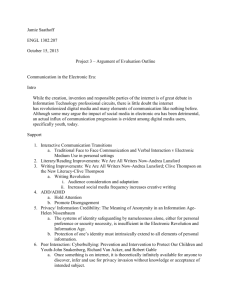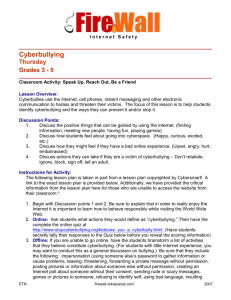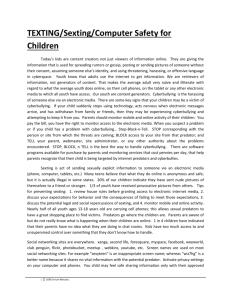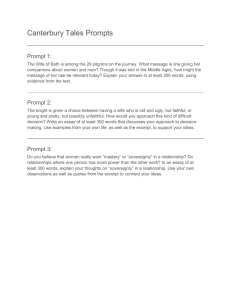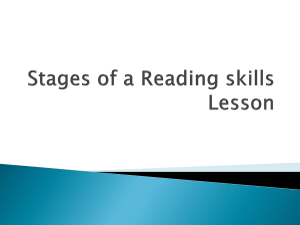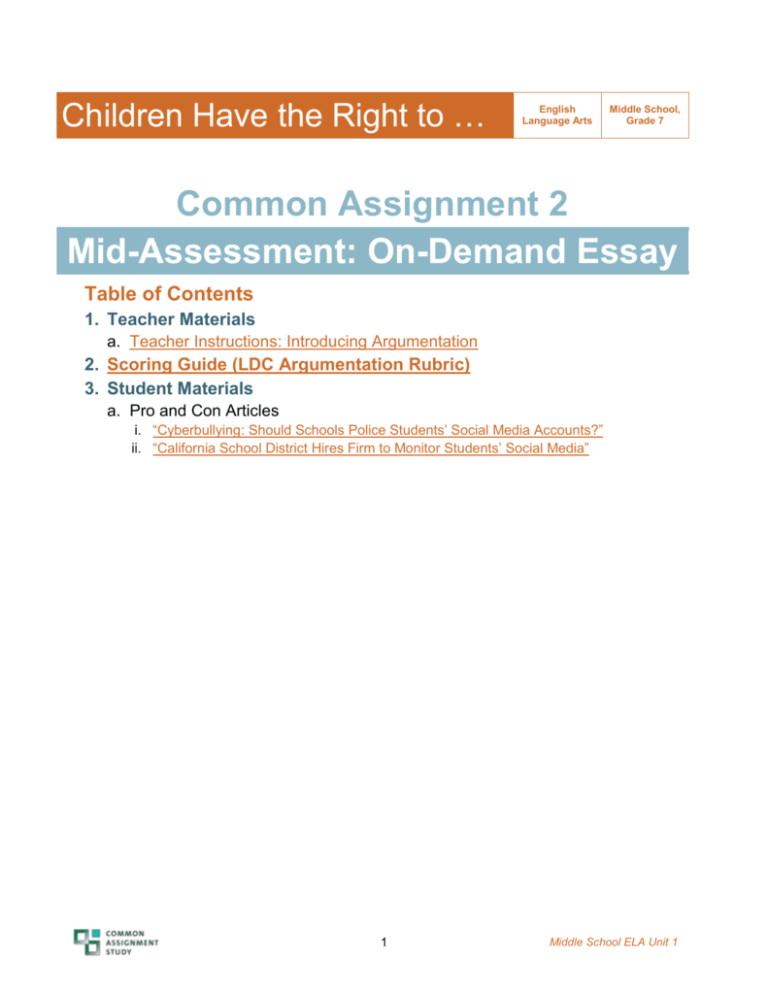
Children Have the Right to …
English
Language Arts
Middle School,
Grade 7
Common Assignment 2
Mid-Assessment: On-Demand Essay
Table of Contents
1. Teacher Materials
a. Teacher Instructions: Introducing Argumentation
2. Scoring Guide (LDC Argumentation Rubric)
3. Student Materials
a. Pro and Con Articles
i. “Cyberbullying: Should Schools Police Students’ Social Media Accounts?”
ii. “California School District Hires Firm to Monitor Students’ Social Media”
1
Middle School ELA Unit 1
Children Have the Right to …
Common Assignment 2
Teacher Instructions: Introducing Argumentation
Ninety-minute on-demand writing
Prompt:
Should schools monitor students’ social media accounts? After reading “Cyberbullying: Should schools police
students’ social media accounts?” and “California School District Hires Firm to Monitor Students’ Social Media”
write an essay in which you address the question and argue your position on the topic. Support your position
with evidence from the text. Be sure to acknowledge competing views. Include a works cited page and text
citations using MLA format.
2
Middle School ELA Unit 1
Children Have the Right to …
Common Assignment 2
Argumentation Teaching Task Rubric for Template Task Collection 2
Scoring
Elements
1
2
3
Addresses prompt appropriately
and maintains a clear, steady focus.
Provides a generally convincing
position. D1: Be sure to
acknowledge competing views…
does this sufficiently.
4
Focus
Attempts to address prompt, but
lacks focus or is off-task. D1: Be
sure to acknowledge competing
views… doesn’t make any
attempts.
Addresses prompt appropriately
and establishes a position, but
focus is uneven. D1: Be sure to
acknowledge competing views…
tries to make an attempt.
Addresses all aspects of prompt
appropriately with a consistently
strong focus and convincing
position. D1: Be sure to
acknowledge competing views…
with thoroughness and making
connections to the prompt.
Development
Attempts to provide details in
response to the prompt, but lacks
sufficient development or relevance
to the purpose of the prompt.
Presents appropriate details to
Presents appropriate and sufficient
support and develop the focus,
details to support and develop the
controlling idea, or claim, with minor focus, controlling idea, or claim.
lapses in the reasoning, examples,
or explanations.
Presents thorough and detailed
information to effectively support
and develop the focus, controlling
idea, or claim.
Organization
Attempts to organize ideas, but
lacks control of structure.
Uses an appropriate organizational
structure for development of
reasoning and logic, with minor
lapses in structure and/or
coherence.
Maintains an appropriate
organizational structure to address
specific requirements of the prompt.
Structure reveals the reasoning and
logic of the argument.
Maintains an organizational
structure that intentionally and
effectively enhances the
presentation of information as
required by the specific prompt.
Structure enhances development of
the reasoning and logic of the
argument.
Conventions
Attempts to demonstrate standard
English conventions, but lacks
cohesion and control of grammar,
usage, and mechanics. Sources are
used without citation.
Demonstrates an uneven command
of standard English conventions
and cohesion. Uses language and
tone with some inaccurate,
inappropriate, or uneven features.
Inconsistently cites sources.
Demonstrates a command of
standard English conventions and
cohesion, with few errors.
Response includes language and
tone appropriate to the audience,
purpose, and specific requirements
of the prompt. Cites sources using
appropriate format with only minor
errors.
Demonstrates and maintains a welldeveloped command of standard
English conventions and cohesion,
with few errors. Response includes
language and tone consistently
appropriate to the audience,
purpose, and specific requirements
of the prompt. Consistently cites
sources using appropriate format.
Template Task Collection 2 | © Literacy Design Collaborative, June 2013, Edited Version 7
3
Middle School ELA Unit 1
Children Have the Right to …
Common Assignment 2
Cyberbullying: Should schools police students'
social media accounts?
Daniel B. Wood, The Christian Science Monitor
September 17, 2013
The Glendale Unified School District in Glendale, Calif., finds itself under a national spotlight
over its hiring of a firm to monitor its 14,000 students’ social media accounts.
In the wake of the suicide of 12-year-old Rebecca Sedwick in Florida last Tuesday—reportedly
after receiving taunting text messages from at least 15 girls—many cyberbullying experts are
applauding the Glendale decision. But others say the Glendale Unified School District (GUSD),
though well-meaning, is entering dangerous moral and legal ground. At least one online
petition is out to stop it.
“We think it’s been working very well,” Superintendent Dick Sheehan told CNN of the policy.
After two teens in the area committed suicide last year, including one in the Glendale district,
the GUSD started a pilot program for 9,000 students in its three high schools. It went so well
that they formally introduced it this year as school opened Sept. 12. “It’s designed around
student safety and making sure kids are protected,” Mr. Sheehan said.
The GUSD is paying the Hermosa Beach-based firm, Geo Listening, $40,500 to track public
postings, searching for such topics as possible truancy, drug use, suicide threats, bullying, and
other violence. Only the postings of students aged 13 and older are monitored, because that is
the legal age at which parental permission isn’t required.
But in hosts of local broadcasts and newspaper articles, parents and students are being
interviewed who don’t think it is right.
“It’s students’ expression of their own thoughts and feelings to their friends,” said Young Cho, a
16-year-old junior at Herbert Hoover High School, to the Los Angeles Times. “For the school to
intrude in that area—I understand they can do it, but I don’t think it's right.”
And some cyberbullying experts also feel it is not wise.
“Should a school take on the responsibility of overseeing social media or their students? No.
The liability is far greater than the school, or their attorneys, understand,” said Robert
Fitzgerald, a cybersecurity expert. “They run the risk of policing the Internet for these kids—a
16-year-old student dating an 18-year-old student, for example—throw in sexual activity and
risque posts—could lead to charges of statutory rape. And if the school does not report it, does
the youngsters family have a claim against the school?”
Some experts say they would applaud the idea only if it is tweaked slightly.
“This is a great idea but only if it’s paired with an educational component; otherwise, it’s just
being police, which is a bad idea,” says Katie LeClerk Greer, former director of Internet safety
for the Massachusetts Attorney General’s Office and intelligence analyst for the Massachusetts
State Police.
She says the educational component would involve explaining to students how putting too
much personal information online—personal pictures, travel intentions, party plans, dating
4
Middle School ELA Unit 1
Children Have the Right to …
Common Assignment 2
details—is a bad idea. She and others say the task for this company to sort out what is worth
reporting and what is not is gargantuan and runs into a huge gray area.
“I hope they have hired and consulted a very able legal team, because even though their
hearts are in the right place, they are possibly biting off more than they can chew,” says Ms.
Greer.
According to a recent poll from 1World Online, 59 percent of people believe that schools
should not be allowed to monitor students’ social media accounts to ensure safety. And
research from the Cyberbullying Research Center found that about half of young people have
experienced some form of cyberbullying, and 10 to 20 percent experience it regularly.
“We know this is on the increase because the devices and apps that kids use is growing
exponentially,” says Tom Jacobs, author of “Teen Cyberbullying Investigated.”
“These kids live with these devices and they are their lifelines to everything," he adds. Because
of this, a lot of the behavior goes unreported, because young people don’t want to risk their
parents taking away their lifelines, shutting off their cellphones or shutting their Facebook and
Twitter accounts, he adds.
But while some parents have complained that this practice amounts to government spying into
private lives, legal analysts say the district is well within its rights to pursue the idea.
“The US Supreme Court has ruled that there are very distinct protections of privacy under the
Constitution, but it has also ruled that privacy rights have to be balanced with the school’s
responsibility to maintain a safe campus,” says Areva Martin, founding and managing partner
of Martin & Martin, LLP, a Los Angeles-based law firm. “So they are trying to address the kinds
of violent speech that can lead students to suicide.”
But just knowing that monitoring is taking place will change the very nature of the
communications, some critics say.
“The response is understandable, but students will feel their speech chilled knowing that the
school district is watching,” says Anupam Chander, director of the California International Law
Center, at the University of California, Davis.
Others say a growing number of cyberbullying incidents point to the need for greater
involvement by both parents and schools and that perhaps a multipronged strategy might be
better.
“Most parents don’t have a clue about how these social media sites and apps work, so some
training there would be in order,” says Suzanne Bogdan, education chair for Fisher & Phillips,
one of the nation's largest labor and employment firms, who advises teachers, administrators
and parents how to deal with cyberbullying.
There are a growing number of apps that are not public, she notes. After Tricia Norman,
Rebecca Sedwick’s mother moved her daughter out of school, and changed her cell phone,
Rebecca signed on to new applications—ask.fm, Kik and Voxer—which restarted the
messaging and bullying she had experienced at her first school. Ms. Norman had complained
to school authorities about the cyberbullying and said that the school hadn't done enough to
help.
5
Middle School ELA Unit 1
Children Have the Right to …
Common Assignment 2
At a Sept. 12 press conference, Sheriff Grady Judd of Polk County, Fla., read a list of the
taunts to Sedwick: “Why are you still alive?” “You’re ugly” “Can u die please?”
http://www.csmonitor.com/USA/Education/2013/0917/Cyberbullying-Should-schools-policestudents-social-media-accounts-video
6
Middle School ELA Unit 1
Children Have the Right to …
Common Assignment 2
California School District Hires Firm to Monitor Students' Social
Media
Michael Martinez, CNN
Updated 10:40 AM EDT, Wed September 18, 2013
Los Angeles (CNN)—A suburban Los Angeles school district is now looking at the public
postings on social media by middle and high school students, searching for possible violence,
drug use, bullying, truancy and suicidal threats.
The district in Glendale, California, is paying $40,500 to a firm to monitor and report on 14,000
middle and high school students' posts on Twitter, Facebook and other social media for one
year.
Though critics liken the monitoring to government stalking, school officials and their contractor
say the purpose is student safety.
As classes began this fall, the district awarded the contract after it earlier paid the firm, Geo
Listening, $5,000 last spring to conduct a pilot project monitoring 9,000 students at three high
schools and a middle school. Among the results was a successful intervention with a student
"who was speaking of ending his life" on his social media, said Chris Frydrych, CEO of the
firm.
That intervention was significant because two students in the district committed suicide the
past two years, said Superintendent Richard Sheehan. The suicides occurred at a time when
California has reduced mental health services in schools, Sheehan said.
"We were able to save a life," Sheehan said, adding the two recent suicides weren't outside
the norm for school districts. "It's just another avenue to open up a dialogue with parents about
safety."
In another recent incident, a student posted a photo of what appeared to be a gun, and a
subsequent inquiry determined the gun was fake, Sheehan said.
Still, school administrators spoke with the parents of the student, who wasn't disciplined, the
superintendent said.
"We had to educate the student on the dangers" of posting such photos, Sheehan said. "He
was a good kid. ... It had a good ending."
In fact, no student has yet to be disciplined under the monitoring, but it's not out of the question
if analysts find a message warranting action, such as a threat of a campus shooting, Sheehan
said this week.
"I can see turning it over to police. That would be a situation in which discipline would follow,"
he said.
Frydrych's firm scours the social media postings of Glendale students aged 13 and older—the
age at which parental permission isn't required for the school's contracted monitoring—and
sends a daily report to principals on which students' comments could be causes for concern,
Frydrych said.
7
Middle School ELA Unit 1
Children Have the Right to …
Common Assignment 2
The company won't disclose its methods and practices in gathering the students' messages,
but it does use key words in its searches. The firm also didn't disclose how it confirms the
youths are indeed students of the district.
To do the work, Frydrych employs no more than 10 full-time staffers—as well as "a larger
portion" of contract workers across the globe who labor a maximum of four hours a day
because "the content they read is so dark and heavy," Frydrych said.
"It's mostly kids hanging onto a thread of life," Frydrych said, "and they're posting to people
also hanging on to a thread."
He declined to disclose how many school campuses have retained his firm, founded this past
January in Hermosa Beach, California. Frydrych has been providing technology services to
school districts the past 10 years.
Geo Listening also monitors whether students are talking about drug use, cutting class or
violence. The firm even ascertains whether pupils are using their smartphone during class
time, Frydrych said.
While critics say the Glendale schools' contract is an invasion of privacy, Frydrych said his firm
helps schools bridge a digital-age communications "chasm."
"Parents and school district personnel—they are not able to effectively listen to the
conversation where it's happening now," Frydrych said. "The notion about talking in class is
about as old-fashioned as a Studebaker, no offense to the makers of the car.
"When was the last time you sent a kid to the principal's office for talking in class too much? I
just don't think it happens too much. So what we kept seeing is the chasm keeps building
between how students communicate and the ability to tell adults about what's going on in their
lives," he said. "I thought we could bridge that gap."
Some experts in digital media and privacy, however, take exception.
"This is the government essentially hiring a contractor to stalk the social media of the kids,"
said Lee Tien, senior staff attorney for the Electronic Frontier Foundation, a nonprofit that
defends privacy, free speech and consumer rights.
"When the government—and public schools are part of the government—engages in any kind
of line-crossing and to actually go and gather information about people away from school, that
crosses a line," Tien said.
He disagreed with school officials who say they are monitoring only public postings.
"People say that's not private: It's public on Facebook. I say that's just semantics. The question
is what is the school doing? It's not stumbling into students—like a teacher running across a
student on the street. This is the school sending someone to watch them," Tien said.
Sandy Russell, president of the school district's PTA, said parents have many questions about
the monitoring, a topic that will be addressed later this month when the superintendent makes
his regular appearance at a PTA meeting.
Parents want to know how and why this is being done, Russell said.
"If it supports a child in a difficult situation—whether it's bullying or stress level—and if it helps,
any parent would be thrilled to have the help. But how is that happening?" Russell said.
8
Middle School ELA Unit 1
Children Have the Right to …
Common Assignment 2
"When you find something you're concerned about, what are you doing? Do you approach the
child, with or without the parents? What does this mean? When people don't have information,
they make up scenarios," Russell said. "Some of the concerns I've heard is when kids say
something nasty about a teacher, will they get in trouble? I understand that's not even remotely
possible."
Superintendent Sheehan said students won't be disciplined for commonplace criticism.
"As far as anything said about teachers, as long as it's appropriate, it will be ignored," he said.
Frydrych's firm doesn't hack into private postings by students, nor their e-mail or text
messages.
"I find it interesting that people keep asking if we're doing something illegal or snooping or
eavesdropping, but what we're actually doing is looking at public posts," Frydrych said. "We
don't see any private posts."
Students can adjust their privacy settings if they don't want the world to see their tweets or
Facebook updates.
Frydrych's analysts stay abreast of the symbols, phonetic spellings, abbreviations, initials and
other code-speak that youths type on social media.
Hate, for example, could be spelled "h8," and teens may refer to drugs with such words as
"red," "rolling," and "blunt," Frydrych said.
In another example, Frydrych's firm learned how youths use drugs such as liquid hashish
through vaporizers, or "vapes," which are devices like electronic cigarettes that allow for
inhalation without creating smoke, Frydrych said.
Teachers may not be aware that students are dipping their mouths into their jacket in order to
take a hit off their "vapor pen," Frydrych said.
Frydrych's team will be able to spot whether the student or a classmate posts a public
message about that activity—with a message stating, for example, "can't believe a kid is
getting high in geography right now, sucking on their vape," Frydrych said.
What school officials do with the daily findings of Geo Listening is up the district, Frydrych said.
"This isn't about our company questioning parents," he said. "We fully respect the challenges
of being parents.
"We enforce the code of student conduct for every school we serve" by compiling a day-by-day
report, he said. "It's up to the district to handle it."
His firm is about to expand schools' monitoring capacity with a new smartphone app that
allows students and parents to anonymously report to and correspond with school officials
about conduct violations.
"Honestly, we're not spying on kids. Can we focus back on the problem: The problem is we're
not listening effectively," Frydrych said. "And we're shifting that."
© 2013 Cable News Network. Turner Broadcasting System, Inc. All Rights Reserved.
http://www.cnn.com/2013/09/14/us/california-schools-monitor-social-media
9
Middle School ELA Unit 1

